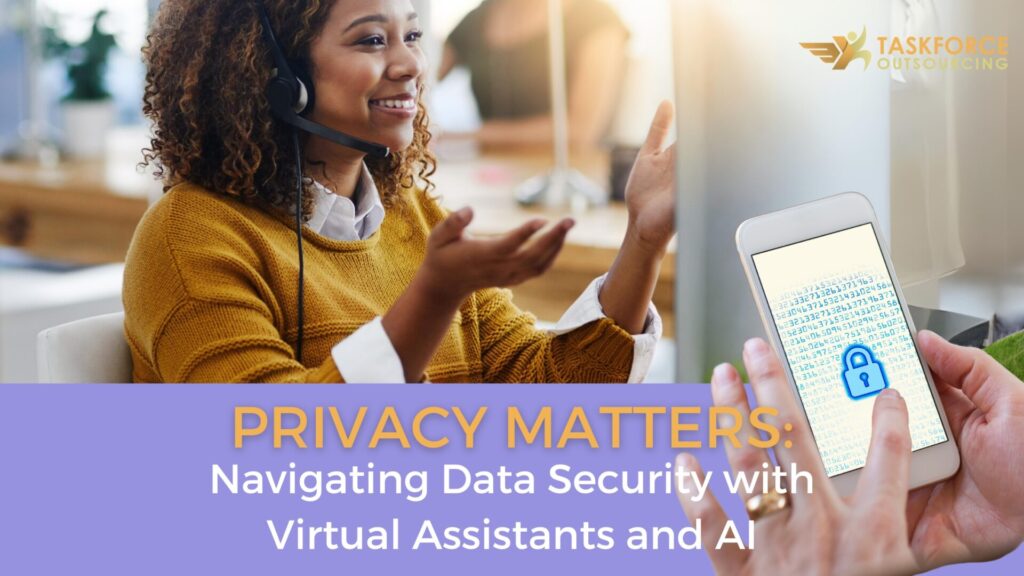At the centre of the ever-evolving digital landscape is data, where it reigns supreme. The intersection of privacy and technology becomes a focal point of concern. This article delves into data security, specifically navigating the privacy challenges posed by Virtual Assistants (VAs) and Artificial Intelligence (AI).
Understanding Data Security Challenges
As businesses increasingly rely on VAs and AI for streamlined operations, understanding the nuances of data security becomes of utmost importance. The rise of technology brings with it a dual responsibility: harnessing the benefits of automation while safeguarding sensitive information from potential threats.
The Rise of Virtual Assistants
and AI
Virtual Assistants and AI have become integral components of modern businesses, offering efficiency, insights, and innovation. However, the very nature of their functionalities raises questions about how effectively they handle and protect the privacy of the data they interact with.
Privacy Concerns

Virtual Assistant Data Handling Practices
Virtual Assistants, designed to understand and respond to natural language, necessitate access to a considerable amount of data. Privacy concerns arise around how these assistants handle sensitive information, the extent of data retention, and the protocols in place to protect user privacy.
AI Security Challenges
AI, powered by machine learning algorithms and vast datasets, faces challenges related to data security. The potential vulnerabilities in AI systems include biassed algorithms, unauthorised access, and the ethical implications of decision-making based on historical data.
Balancing Act
Navigating Privacy with Virtual Assistants
Balancing the benefits of Virtual Assistants with user privacy requires a thoughtful approach. Businesses must establish transparent data handling practices, clearly communicate privacy policies, and implement mechanisms that empower users to control the extent of information shared.
Addressing Security Gaps in AI Systems
For AI, addressing security gaps involves constant vigilance. From ensuring algorithmic fairness to fortifying against cyber threats, businesses need to adopt proactive measures to strengthen the security posture of their AI systems.
Lessons from AI Security Errors
Examining instances where AI systems faced security gaps and the lessons learned from these mishaps. Understanding the pitfalls allows businesses to fortify their AI implementations against potential threats.
Safeguarding Data: Best Practices
Encryption as a Pillar of Security
Implementing end-to-end encryption ensures that sensitive data remains secure during transmission and storage. This cryptographic measure acts as a safeguard against unauthorised access, providing users with peace of mind.
User Education and Consent
Empowering users with knowledge about data security and obtaining explicit consent for data processing are pivotal steps. Transparent communication builds trust and allows users to make informed decisions regarding their privacy.
Continuous Monitoring and Updating
The ever-evolving nature of cybersecurity threats necessitates continuous monitoring and prompt updates to security protocols. Regular assessments and enhancements are crucial in staying one step ahead of potential breaches.
Decision-Making Factors
Evaluating Privacy Impact in Business Decisions
Businesses must evaluate the privacy impact when integrating VAs and AI into their operations. This involves conducting privacy impact assessments, considering the type of data processed, and aligning technological choices with privacy objectives.
Incorporating Security in AI Adoption
As businesses adopt AI, security considerations should be integrated from the outset. This involves collaborating with cybersecurity experts, implementing robust access controls, and staying abreast of evolving security standards.
Human Element

Recognizing the role of users in maintaining data security, particularly with VAs. Educating users about privacy settings, permissions, and providing them with control over their data enhances the overall privacy framework.
Trust-building with Virtual Assistant Users
Building trust with users is pivotal. Businesses should transparently communicate privacy practices, offer opt-in features, and demonstrate a commitment to safeguarding user data, thereby fostering a sense of trust in Virtual Assistant interactions.
Challenges and Future Trends
Anticipating future privacy challenges involves considering the evolving nature of technology and the potential implications of data-driven decision-making. Businesses need to be proactive in identifying and addressing emerging privacy concerns.
Strategies for Future-proofing Data Security
Future-proofing data security entails adopting a holistic approach that combines technological advancements with comprehensive privacy policies. Businesses should strategize to stay ahead of potential threats and ensure ongoing data protection.
Evolving Data Security Landscape
The future holds promising trends in data security, including advancements in encryption, decentralised identity solutions, and the integration of privacy-preserving technologies. Businesses can anticipate these trends to stay ahead in safeguarding data.
Innovations in Virtual Assistant Privacy
Innovations in Virtual Assistant privacy are on the horizon, with developments in differential privacy, on-device processing, and enhanced user controls. These innovations aim to address current privacy concerns and elevate user confidence.
Conclusion
In the digital age, the key is to balance taking advantage of Virtual Assistants and AI while ensuring robust data security. As businesses continue to evolve in this landscape, a commitment to privacy and proactive security measures will be pivotal in maintaining user trust and meeting regulatory expectations.
Frequently Asked Questions (FAQs)
A: Encryption is crucial for safeguarding sensitive information, especially personally identifiable data. While not mandatory for all data, its application depends on the nature and sensitivity of the information.
A:Regular security audits should be conducted periodically, with the frequency determined by factors such as the volume of data handled, industry regulations, and the evolving threat landscape. Quarterly or bi-annual audits are common practices.
A: This includes disclosing the purposes for which the data is used, the types of AI algorithms employed, and any third-party partnerships involved in data processing.
A: Advanced security technologies and protocols should be employed to prevent data breaches and unauthorised access. This includes firewalls, intrusion detection systems, multi-factor authentication, and regular security training of staff to ensure they are aware of best practices and potential risks.
A: It's important to choose reputable providers with a proven track record of prioritising data protection. Additionally, familiarising with privacy settings and permissions, and regularly reviewing access controls to ensure they align with privacy preferences.


